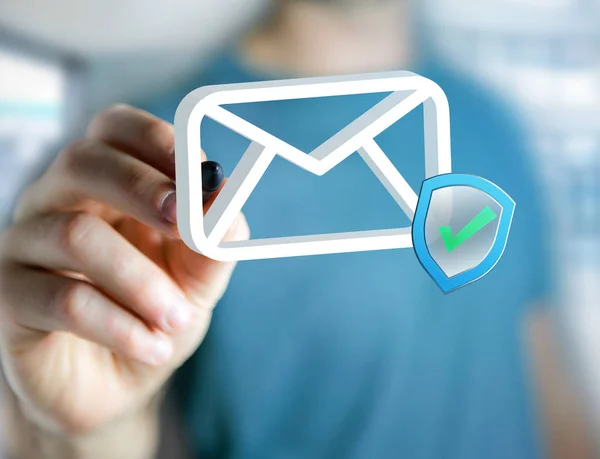DMARC Record Best Practices For Enhancing Email Deliverability
In today's digital landscape, email communication remains one of the most vital channels for businesses to engage with their customers. However, ensuring that your emails reach their intended recipients' inboxes can be a challenging task. With the prevalence of spam, phishing, and spoofing attacks, email deliverability has become a significant concern for organizations worldwide. One effective solution for enhancing email deliverability is the implementation of DMARC (Domain-based Message Authentication, Reporting, and Conformance) records. In this article, we will explore the best practices for configuring DMARC records to improve email deliverability.
Understanding DMARC
DMARC is an email authentication protocol that allows domain owners to specify how email messages from their domain should be handled by mail servers. It works by enabling domain owners to publish policies in DNS records, instructing receiving mail servers on how to handle messages that fail authentication checks. DMARC builds on two existing email authentication mechanisms: SPF (Sender Policy Framework) and DKIM (DomainKeys Identified Mail).
Benefits of DMARC
Implementing DMARC offers several benefits for organizations aiming to improve their email deliverability:
Enhanced Email Security
DMARC helps prevent email spoofing and phishing attacks by allowing domain owners to specify which actions receiving mail servers should take when an email fails authentication checks. By enforcing strict policies, organizations can protect their brand reputation and mitigate the risk of fraudulent activities.
![]()
Improved Deliverability
By configuring DMARC policies, organizations can provide clear instructions to receiving mail servers on how to handle emails that fail authentication checks. This helps reduce the likelihood of legitimate emails being marked as spam or rejected, thereby improving overall deliverability rates.
Visibility and Reporting
DMARC provides domain owners with valuable insights into email authentication failures through aggregate and forensic reporting. These reports allow organizations to identify sources of unauthorized email activity, monitor the effectiveness of their authentication mechanisms, and take corrective actions to enhance security and deliverability.
Best Practices for DMARC Configuration
Start with a Monitoring-only Policy
When implementing DMARC for the first time, it's recommended to start with a "monitoring-only" policy (p=none). This policy instructs receiving mail servers to send DMARC reports without taking any action on emails that fail authentication checks. By analyzing these reports, organizations can assess the impact of DMARC on their email traffic and identify potential issues before enforcing stricter policies.
Gradually Enforce Policies
Once organizations have gained confidence in their DMARC configuration and have addressed any issues identified during the monitoring phase, they can gradually move towards enforcing policies that specify how receiving mail servers should handle emails that fail authentication checks. This typically involves changing the DMARC policy to either "quarantine" (p=quarantine) or "reject" (p=reject), depending on the organization's risk tolerance and email infrastructure readiness.

Utilize SPF and DKIM Alignment
DMARC allows domain owners to specify alignment requirements for SPF and DKIM authentication mechanisms. Alignment ensures that the "From" header domain matches either the "Return-Path" domain (for SPF) or the "d=" domain (for DKIM) in the email message. By enforcing alignment, organizations can prevent malicious actors from spoofing their domains and improve the effectiveness of DMARC enforcement.
Monitor DMARC Reports Regularly
Continuous monitoring of DMARC reports is essential for maintaining email security and deliverability. Organizations should regularly review aggregate and forensic reports to identify authentication failures, unauthorized senders, and potential issues with SPF and DKIM configuration. By staying vigilant and proactive, organizations can quickly respond to emerging threats and optimize their DMARC implementation.
Collaborate with Third-party Senders
For organizations that rely on third-party email senders, such as marketing automation platforms or email service providers (ESPs), collaboration is key to ensuring successful DMARC implementation. Domain owners should work closely with their senders to align SPF and DKIM authentication, configure DMARC policies, and monitor email delivery performance. Clear communication and collaboration help establish trust relationships and enhance email deliverability for all parties involved.
Exploring Advanced DMARC Strategies
While the basic configuration of DMARC provides a solid foundation for email authentication and deliverability, organizations can further optimize their DMARC implementation by leveraging advanced strategies and techniques. These advanced approaches help enhance security, maximize email deliverability, and provide greater control over email traffic. Let's delve into some advanced DMARC strategies:
Subdomain Policy Alignment
One of the challenges organizations face with DMARC is ensuring consistent policy alignment across all subdomains. Since subdomains often serve different purposes and may be managed by different teams, maintaining alignment can be complex. However, aligning DMARC policies for subdomains is crucial for preventing domain spoofing and ensuring comprehensive email authentication. Organizations can achieve subdomain policy alignment by:
- Implementing consistent SPF and DKIM configurations across all subdomains.
- Publishing DMARC records for each subdomain and aligning them with the organizational DMARC policy.
- Regularly monitoring DMARC reports to identify any subdomains that are not in alignment and taking corrective actions.
- By aligning DMARC policies for subdomains, organizations can strengthen their overall email security posture and reduce the risk of domain abuse.
Customized DMARC Reporting
While DMARC provides valuable insights into email authentication failures through standard aggregate and forensic reports, organizations can enhance their visibility and reporting capabilities by customizing DMARC reports. Customized reporting allows organizations to tailor reports to their specific requirements, extract relevant data, and gain deeper insights into email traffic and authentication mechanisms. Some ways to customize DMARC reporting include:
- Selecting specific data fields and metrics to include in reports, such as message disposition, authentication results, and message sources.
- Filtering and aggregating report data based on criteria such as sender domain, message disposition, and authentication failures.
- Integrating DMARC reporting with existing security information and event management (SIEM) systems or threat intelligence platforms for centralized monitoring and analysis.
By customizing DMARC reporting, organizations can gain actionable insights into email authentication failures, identify patterns and trends, and make informed decisions to improve email security and deliverability. Visit Dmarcreport for more such details.

